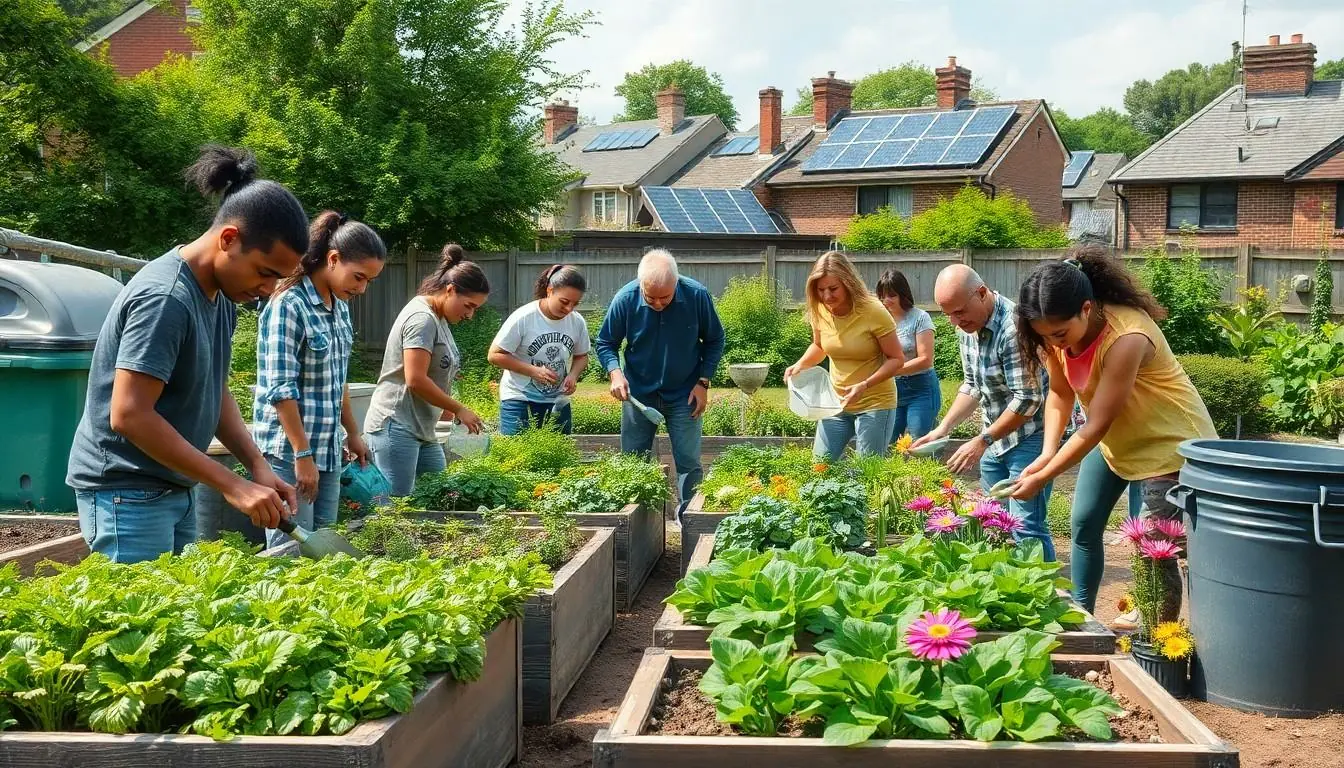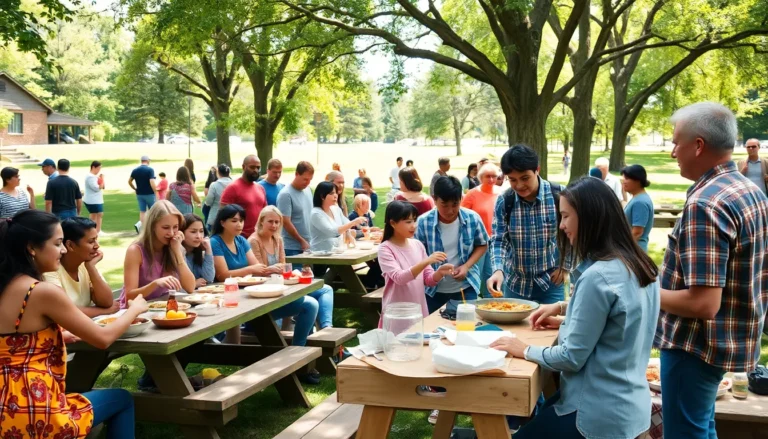Table of Contents
ToggleImagine living in a place where the air smells fresh, the gardens flourish, and neighbors actually know each other’s names. Welcome to sustainable community living, where eco-friendly practices meet good old-fashioned neighborliness. It’s not just a trend; it’s a lifestyle that’s gaining traction faster than a cat chasing a laser pointer.
In a world where convenience often trumps care for the environment, sustainable communities are like a refreshing splash of cold water. They promote harmony with nature while fostering connections among residents. Whether it’s sharing resources or hosting potlucks with locally sourced ingredients, these communities are redefining what it means to live well. So, why not join the movement? Embrace a life that’s not only good for you but also great for the planet. After all, who wouldn’t want to be part of a community that’s as sustainable as it is fun?
Overview of Sustainable Community Living
Sustainable community living focuses on harmonious coexistence with the environment and fellow residents. This lifestyle blends eco-friendly practices with social interconnectedness. Residents often engage in resource sharing, such as community gardens and co-housing initiatives, promoting both sustainability and camaraderie.
Shared resources yield significant benefits. For instance, living in close proximity reduces carbon footprints through less reliance on personal vehicles. Community events foster relationships, strengthening bonds between neighbors and enhancing the overall quality of life.
Residents adopt practices like composting and recycling, minimizing waste and encouraging responsible consumption. Local markets offer fresh produce, supporting both health and local economies. Green technologies, such as solar panels, become more prevalent, further reducing environmental impacts.
Successful sustainable communities also prioritize education. Workshops on sustainable practices empower residents to make informed decisions. This proactive approach creates a culture of sustainability, inspiring others to join the movement.
Diverse layouts and designs define many sustainable communities. Features commonly include pedestrian pathways, green spaces, and communal areas. These elements create inviting environments, ensuring that social interactions flourish.
In essence, sustainable community living represents a commitment to environmental stewardship and strong social networks. Emphasizing collaboration and resource sharing enriches residents’ lives while addressing urgent ecological challenges. Residents’ dedication to this lifestyle creates a model for others, demonstrating the possibilities in achieving a balanced and sustainable future.
Principles of Sustainable Community Living

Sustainable community living encompasses essential principles that shape environmentally friendly and socially cohesive environments. Three primary pillars guide this approach: environmental sustainability, social sustainability, and economic sustainability.
Environmental Sustainability
Environmental sustainability emphasizes practices that lessen ecological impact. Composting food waste reduces landfill contributions, while recycling programs divert materials from waste streams. Using green technologies, such as solar panels, provides renewable energy and minimizes carbon footprints. Residents engage in urban gardening, promoting local food production and biodiversity. Communities often prioritize natural landscaping and water conservation measures, fostering habitats for wildlife. Sustainable practices contribute to cleaner air and healthier neighborhoods, enhancing residents’ quality of life.
Social Sustainability
Social sustainability fosters inclusive environments where relationships thrive. Building strong neighborly connections creates support networks and enhances cooperation among residents. Communities organize events that encourage social interaction, such as farmers’ markets or cultural festivals. Access to shared spaces, such as parks or community gardens, invites collaboration and strengthens bonds. Education plays a vital role, as workshops teach valuable skills and sustainable practices. Active participation in local governance ensures that residents’ voices influence decision-making processes, promoting a sense of belonging.
Economic Sustainability
Economic sustainability underscores the importance of local economies. Supporting local businesses bolsters employment opportunities and helps retain financial resources within the community. Cooperative initiatives allow residents to share tools and services, lowering individual costs while promoting resource efficiency. Investment in sustainable infrastructure, such as public transit, encourages environmentally friendly commuting options. Communities often focus on affordable housing solutions, ensuring inclusivity and accessibility. By prioritizing economic resilience, sustainable communities thrive while addressing broader social and environmental challenges.
Benefits of Sustainable Community Living
Sustainable community living offers numerous advantages that enhance the lives of residents. From improved quality of life to stronger community bonds and reduced environmental impact, these benefits contribute to a thriving, interconnected society.
Improved Quality of Life
Engagement in sustainable community living enhances residents’ overall quality of life. Shared resources lead to decreased living costs, while communal spaces provide enjoyable areas for recreation and relaxation. Access to local produce through urban gardens encourages healthier eating habits. Participating in community events fosters a sense of belonging and boosts mental well-being. These factors collectively create an environment where personal growth and wellness flourish.
Community Cohesion
Stronger community cohesion often emerges in sustainable living settings. Neighbors build meaningful relationships by sharing resources and participating in communal activities. Engaging in workshops and events allows individuals to connect on various levels, strengthening social ties. Residents collaboratively solve challenges, fostering a support network essential for resilience. An inclusive atmosphere encourages diverse participation, enhancing the overall community spirit.
Environmental Impact
Sustainable community living significantly reduces environmental impact. Implementing practices such as recycling, composting, and using renewable energy sources lowers carbon footprints. Shared transportation options cut down on individual vehicle use, decreasing pollution levels. Urban gardening contributes to biodiversity while providing fresh produce. By prioritizing eco-friendly practices, these communities champion sustainability and set examples for broader society.
Challenges of Sustainable Community Living
Sustainable community living faces several challenges that impact its effectiveness.
Financial Constraints
Financial constraints significantly affect the creation and maintenance of sustainable communities. Limited funding for green initiatives can hinder the implementation of renewable energy sources or community gardens. Many residents may struggle with initial costs of sustainable technologies despite long-term savings. Affordability of eco-friendly options varies, leading to unequal access among community members. Cooperative funding models can ease financial burdens but often require a collective willingness to invest. Sustained financial support from external organizations or government grants plays a crucial role in overcoming these challenges.
Policy and Regulation Barriers
Policy and regulation barriers also present significant obstacles to sustainable community living. Zoning laws may restrict the use of land for community gardens or renewable energy installations. Many local governments lack incentives for sustainable practices, which dissuades implementation. Complex permitting processes can delay innovative projects, frustrating both residents and advocates. Collaboration with policymakers is essential for aligning community goals with regulations. Advocating for policy changes creates opportunities for developing a more supportive environment for sustainable initiatives.
Examples of Successful Sustainable Communities
Various communities worldwide exemplify principles of sustainable living. EcoVillage in Ithaca, New York, incorporates renewable energy sources and organic farming practices. Residents share resources like tools, cars, and fruits from community gardens, enhancing their lifestyles while reducing environmental impact.
The Findhorn Foundation in Scotland highlights community-based environmental solutions. Its members focus on permaculture, creating a rich biodiversity within the grounds. Regular workshops engage participants in eco-friendly practices and empower them to make personal changes.
In California, the city of Davis emphasizes biking as a primary mode of transportation. The extensive bike paths encourage reduced car usage, leading to lower carbon emissions. Local farmers’ markets support regional produce, strengthening the local economy and fostering health-conscious habits.
Another notable example is the village of Arcosanti in Arizona, designed to promote urban living harmoniously with nature. This community utilizes innovative architecture and techniques aimed at minimizing environmental footprints. Residents participate in hands-on workshops and engage in sustainable building practices.
Tamarack is an eco-neighborhood in Missoula, Montana. Its design promotes walkability and green spaces, encouraging sociable interactions among residents. With community involvement, Tamarack emphasizes the importance of shared amenities and cooperative initiatives.
Ecovillage at Ithaca represents a strong attempt at communal living, grounded in sustainable agriculture. The intentional design fosters relationships between residents and their environment. Additionally, educational programs equip participants with the skills needed to lead sustainable lifestyles.
These communities showcase diverse approaches to sustainable living while emphasizing environmental and social responsibilities. Each represents an opportunity for individuals seeking a compatible lifestyle that reflects eco-conscious values.
Sustainable community living represents a transformative approach to daily life that prioritizes the well-being of both individuals and the environment. By embracing eco-friendly practices and fostering strong connections among residents, these communities create a supportive and enriching atmosphere.
The blend of environmental, social, and economic sustainability empowers individuals to thrive while reducing their ecological footprint. As more people recognize the benefits of shared resources and local engagement, the movement toward sustainable living continues to grow.
Choosing to be part of this movement not only enhances personal quality of life but also contributes to a healthier planet for future generations. Together, they can build a brighter and more sustainable future.






